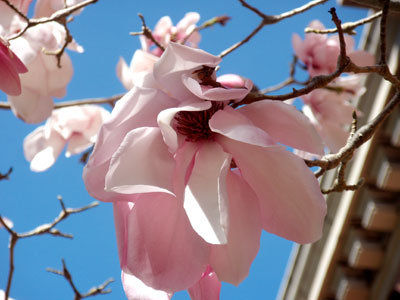
I went to see a million daffodils, but I was too early.
Filoli Gardens in Woodside has suffered from lack of rainfall like the rest of us, and the daffodils know it. The treat I got instead was a massive display of saucer magnolias that filled the warm air with a sweet, lemony fragrance.
This tree loses its leaves in winter, and even in the summer, the large green leaves are not very showy. But come late winter, kaboom — you see them everywhere, totally covered with huge, spectacular flowers. A tree in full bloom with a carpet of petals underneath can beckon us to stay a while.
Magnolias are native to China and have been cultivated in Chinese Buddhist temple gardens since 600 AD. Saucer magnolias (Magnolia soulangeana) were initially bred by French horticulturist Etienne Soulange-Bodin in 1820 at his chateau near Paris. Crossing two types of magnolia, both with already impressive flowers, his new tree produced (in 1826) the spectacular flowers we know today. From France, the hybrid quickly entered cultivation in England and other parts of Europe and also came to the shores of North America. More than a hundred named varieties are now known.
Magnolias, once established, are easy to grow. They are naturally adapted to areas with cool, moist winter conditions like ours.
If you have a lawn, they make a good specimen tree and do well in very large containers. The roots are shallow and don’t like to be disturbed once they are established. If planted in a lawn, leave a grass-free area bare under the canopy, as the fleshy roots can be damaged by constant foot traffic.
Make sure you pick a good spot to plant them — a place in the garden where they can show off their spreading branch structure. Most varieties grow about 20 to 25 feet tall and as wide.
Here are some of my favorites:
Of the many cultivars that are commonly seen, I’m always drawn to Alexandrina. Large, tulip-shaped flowers are deep rosy-purple with dark veins outside and white insides. Rustica Rubra is another stunner with deep reddish-purple cup-shaped flowers.
The variety we call simply saucer magnolia is beautiful, too. Planted in a woodland or Asian-style garden, its white blooms, with pink on the outside, are fragrant like all of the varieties. Gamble Garden in Palo Alto has a beautiful Vulcan variety blooming in its woodland garden. Above the blooming hellebores, ruby-red flowers completely covered this spreading mature specimen. At 10 to 12 feet across, the showy flowers glowed in the late afternoon sun.
Star magnolias (Magnolia stellata) also make a fine addition to the garden. Much smaller than its cousin, this mounding shrubby plant grows only 10 to 15 feet tall but much wider. Often, it is pruned like a small tree to show off the early profusion of striking flowers in white, pink or rose. Star magnolias are valued for their small scale in woodland gardens and are especially beautiful if you can enjoy the early flowering from inside the house.
Deciduous magnolias, along with flowering plums, are among the earliest showy trees to herald in the new season. Valuable for both their stunning flowers and also their sweet scent, they make the late winter garden come alive.
– Jan Nelson, a landscape designer and California certified nursery professional, will answer questions about gardening in the Santa Cruz Mountains. Email her at ja******@*ol.com, or visit www.jannelsonlandscapedesign.com to view past columns and pictures.










